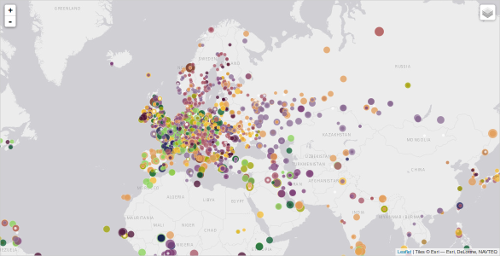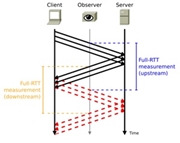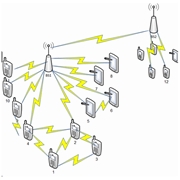Please, see the list of LCCN offered projects:
Project Title:
Ripe-Atlas Internet Communication Analysis Tool
Supervisors:
Dr. Tal Mizrahi, Eran Tavor
Description:
The Internet is a complex and dynamic network, whose performance is constantly changing depending on various factors, such as the nature of communication usage, malfunctions, cyber attacks, political events, and more. Measuring the performance of the internet network makes it possible to analyze its behavior and normality, and also makes it possible to learn about various events that affected the network's behavior.
RIPE Atlas is a global network of thousands of probes that measure Internet connectivity and reachability in real-time. The probes are distributed worldwide and provide valuable data on network performance, stability, and security. Here are some of the types of information that can be extracted from RIPE Atlas:
1. Network performance: RIPE Atlas probes can measure key network performance metrics such as latency, packet loss, and jitter. This information can help network operators and researchers to identify and troubleshoot network problems, as well as to compare performance between different networks.
2. Internet reachability: RIPE Atlas probes can test the reachability of a website or other online service from different locations around the world. This can help website operators to identify and resolve connectivity issues that may be impacting their users.
3. DDoS attacks: RIPE Atlas can be used to detect and mitigate Distributed Denial of Service (DDoS) attacks. By monitoring traffic patterns and network performance, RIPE Atlas probes can help identify and respond to attacks in real-time.
4. DNS performance: RIPE Atlas includes a DNS monitoring service that measures the performance of DNS servers around the world. This can help DNS operators to identify and resolve performance issues that may be impacting the reliability and speed of their services.
5. Internet topology: RIPE Atlas probes can be used to map the topology of the Internet by measuring the paths that packets take between different network nodes. This information can be used to identify key bottlenecks and vulnerabilities in the network, as well as to develop more efficient routing algorithms.
Overall, RIPE Atlas provides a wealth of information on the performance and security of the Internet, which can be valuable to network operators, researchers, and other stakeholders. The goal of the project Is to building a tool that will pull and analyze publicly available statistics (published by RIPE Atlas), as well as analyzing the statistics in order to identify unusual phenomena during the Corona crisis.

Project Title:
Congestion Control Fairness Comparison using NS3
Supervisors:
Eran Tavor
Description:
Congestion Control (CC) is an important role of a connection oriented transport layer (Layer 4) protocol. CC is an End to End (E2E) mechanism that controls the intensity of the traffic an end-station injects into the network. In this project you will study different types of fairness via literature review and simulation on the NS3 cutting-edge network simulator. Quic is a secure general-purpose, )almost fully) encrypted, multiplexed, and low-latency transport protocol designed from the ground up to improve transport performance for HTTPS traffic. QUIC has recently (May 2021) became RFC standard (RFC 9000) and is expected to become the dominant transport protocol in the Internet over TCP. In the simulation part of this project you will study the fairness property of various Quic congestion control mechanisms in various situations.

Project Title:
Windowed backoff algorithms for WiFi using NS3
Supervisors:
Eran Tavor
Description:
Binary exponential backoff (BEB) is a decades -old algorithm for coordinating access to a shared channel. In modern networks, BEB plays a crucial role in WiFi and other wireless communication standards. Despite this track record, well-known theoretical results indicate that under bursty traffic, BEB yields poor makespan, and superior algorithms are possible. In this project you will compare the performance of several backoff algorythms using the NS3 Network Simulator.

Project Title:
Nvidia AI-Based Firewall using P4
Supervisors:
NVIDIA Eng., Eran Tavor
Description:
Nvidia is developing a programmable environment for its switches. This environment supports the P4 language. Programmable hardware, which is not a CPU, is one of the most important verticals in the hardware industry. The goal of this project is to develop a live AI-based firewall.
In this project you will get a glance of the work of system architect. You will use many components to build a complex but working network-based system.
You will:
• Build a live AI-based firewall
• Understand how the components are working. Among them are
o Networking and Linux networking
o Convolutional neural network (CNN) and AI classifier
o Wireshark
o P4 (networking programming language)
o HW networking (basic)
• Integrate those components into a working system
• Learn how to use your time efficiently
o You will understand which components require a deep dive and which you can treat as black box
o The investment in this project will be at the same level of investment as in other projects
o You will enjoy the work of others in previous semesters
• Work closely with Nvidia Engineer that will help you to achieve your goals

Project Title:
Performance Analysis of QUIC and TCP
Supervisors:
Eran Tavor
Description:
The QUIC protocol is a secure and encrypted transport protocol, characterized by multiplexing and low-latency capabilities. Its primary goal is to enhance the performance of HTTPS traffic. Recently standardized as RFC 9000, QUIC is poised to supplant TCP as the dominant transport protocol on the internet. The present research project entails a comparative analysis of TCP and QUIC, focusing on performance and security. The investigation will employ open-source implementations of both protocols.

Project Title:
QUIC Security Analysis
Supervisors:
Alon Dankner, Eran Tavor
Description:
The QUIC protocol is a secure and encrypted transport protocol, characterized by multiplexing and low-latency capabilities. Its primary goal is to enhance the performance of HTTPS traffic. Recently standardized as RFC 9000, QUIC is poised to supplant TCP as the dominant transport protocol on the internet. The present research project entails an analysis of QUIC, focusing on cybersecurity. The investigation will employ open-source implementations of the protocol.

Project Title:
Low_Collateral_BlockChain_Loans
Supervisors:
Tom Azoulay, Eran Tavor
Description:
The aim of this project is to provide an accurate risk assessment of default for loans on Blockchain networks using solely past transactions of the user as a way to estimate.

Project Title:
L3 Router Control Plane
Supervisors:
Eran Tavor
Description:
Routers are traditionally very expensive and complicated devices. In this project you will develop a modern layer 3 router using a novel Switch programmable language (P4). The hardware of the router is based on RaspberryPi 4 Single Board Computer(SBC) and the software is based on the P4 open source compiler T4PAS.
The Router’s design is separated to a Data Plane – programmed in P4 and a Control Plane – programmed in python.

Project Title:
DRL Based Access Network Schedular
Supervisors:
Eran Tavor
Description:
As the demand for mobile high bandwidth – low latency is increasing, the access network must
become smarter and automatically adapt to rapid changes. A scheduler is a module that observes
the network, receive traffic requests from all users and allocates a bandwidth and a specific route to
each requested connection.
In order to accomplish the scheduling task quickly and efficiently, you will develop a Reinforcement
Learning based scheduler that observes the network (the environment), receives traffic requests and
allocates route and bandwidth to each traffic request. The main focus of this semester’s project is to
develop an OMNET++ simulator that will be used as the digital twin of the real-world 6G access network
and replace the Routenet model that was used in last semester project.

Project Title:
QUIC RTT estimation using ML techniques
Supervisors:
Barak Gahtan, Eran Tavor
Description:
QUIC is a secure, encrypted, multiplexed, and low-latency transport protocol (RFC 9000) designed together with HTTP3 (RFC 9114) to improve the performance of HTTPS traffic. QUIC is expected to become the dominant transport protocol on the internet, replacing TCP. Most of the packets in QUIC are encrypted, all of the payload and even most of the header, which makes it difficult for internet service providers (ISPs) and other middleboxes to monitor the network. An important metric that ISPs use to gauge the health of the network is round-trip time (RTT) estimation. If the RTT of many connections becomes very high, it can indicate that queues in routers are building up and the network is at risk of collapsing. In such cases, ISPs may limit the bandwidth of heavy users to prevent network failure.
The purpose of this project is to estimate RTT in case those bits are not available. We believe that various ML techniques can be used to estimate the RTT (as an observer observes the spin bit). One possible direction would be to embed a sliding window of consecutive frames (or properties of frames as (Time of Arrival, Size and Direction) into a picture and then try to extract insights from the picture. Another approach could be to use CNN to exploit session characteristics.
Data set. In this project you will use an Infrastructure that was developed in a past project, that infrastructure can be utilized for generating a tagged pcaps (In which we know everything about the packets’ content, the RTT as the client and server estimate it, and the ‘wire latency’.

Project Title:
QUIC Upper-Layer Application Classification
Supervisors:
Barak Gahtan, Eran Tavor
Description:
Traffic classification, the process of categorizing network traffic into various classes, is essential for various purposes such as quality of service control, pricing, resource planning, malware detection, intrusion detection and more. In recent years, Deep Learning (DL) has emerged as a state-of-the-art technique for traffic classification due to its ability to automatically select features through training and its high capacity for learning complex patterns. DL can learn the nonlinear relationship between raw input and corresponding output without the need for feature selection and classification, but it requires a large amount of labeled data and computational power.
QUIC is a transport protocol designed to improve the performance of encrypted HTTP traffic. It is a secure, highly encrypted, multiplexed protocol that encrypts both the payload and most of the header. Identifying the upper layer application that used the QUIC transport layer is useful for load balancing, Quality of Experience (QOE), Cyber attack mitigation etc.
The goal of this project is to train a model to classify QUIC connection to several classes of upper-layer applications.

Project Title:
QUIC_multi-stream_cassification
Supervisors:
Barak Gahtan, Eran Tavor
Description:
Traffic classification, the process of categorizing network traffic into various classes, is essential for various purposes such as quality of service control, pricing, resource planning, malware detection, intrusion detection and more. In recent years, Deep Learning (DL) has emerged as a state-of-the-art technique for traffic classification due to its ability to automatically select features through training and its high capacity for learning complex patterns. DL can learn the nonlinear relationship between raw input and corresponding output without the need for feature selection and classification, but it requires a large amount of labeled data and computational power.
QUIC is a transport protocol designed to improve the performance of encrypted HTTP traffic. It is a secure, highly encrypted, multiplexed protocol that encrypts both the payload and most of the header. As a multiplexed transport protocol, a single QUIC packet can contain multiple streams of data, allowing for parallel streaming of multiple objects within a single connection. This ability prevents Head of Line Blocking.
The goal of this project is to train a model to estimate the stream cardinality of a QUIC connection.



